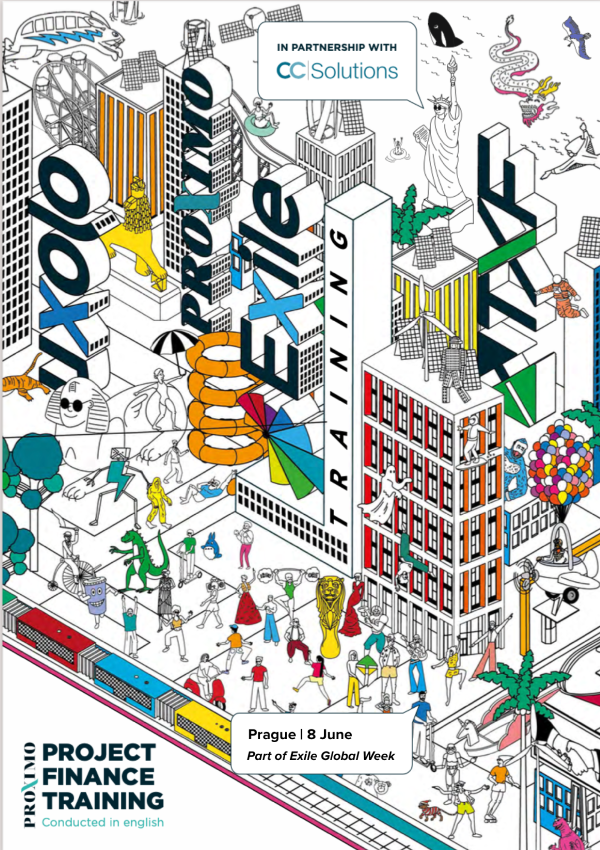Puzzled by credit risk insurance? (part one)
Appetite for credit risk insurance (CRI) for project financings looks set to rise in the wake of fallout from Covid-19. In the first session of a two-part roundtable sponsored by Texel, we explore the market dynamic between banks, DFIs and CRI providers, what project assets fit best with CRI and whether lenders and insurers share the same views on CRI availability and its benefits.

The benefits of credit risk insurance (CRI) are well-known in project finance: completion of deals in excess of bank internal sponsor or deal specific credit limits; optimising use of banks regulatory capital; upping a bank’s ability to sole arrange and avoid introducing borrowers to potential bank competitors in syndication. But given the current unprecedented risk of project default worldwide, is CRI delivering on its promise and what more could it deliver going forward?
Texel and Proximo brought together a panel of experts from insurance, brokerage, commercial banks and DFIs to answer those questions and much, much more. If you ever had questions about CRI you are likely to find the answers below.
Panellists:

Michael Silas – AXIS, Head of Capital Risk Solutions

Jan Weiss – IDB Invest, Principal Investment Officer

Simon Bessant – The Texel Group, Director

Daniel Borrego – EBRD, Associate Director, Loan Syndications

Lotte van Bijsterveld – ABN AMRO, Director, Loan Syndications

Andres Ortiz – Banco Santander, Managing Director, Global Head of Trade Asset Mobilization

Gerard Pieters – NordLB, Head of Origination Energy Europe, Structured Finance

Joe Blenkinsopp – AXA XL, Global Head of Market Development and Distribution for Political Risk, Credit & Bond Insurance
Proximo: How does the market dynamic between banks and CRI providers function and what is playing out in both markets given fallout from Covid-19?
Lotte van Bijsterveld: ABN AMRO is very focused on certain niche sectors within project finance – renewables, energy from waste and digital infrastructure/fibre deals – all of which are holding up well. The reason we would tend to use insurance on those type of deals is to increase the chances of successfully reducing our risk weighted assets on a transaction to the level approved by the credit committee. We are amongst a small group of banks that are able to put large tickets on the table in primary syndication but in light of upcoming capital scarcity due to new regulation (e.g. Basel 4) are often required to sell down our position to efficiently manage capital. So, for us to get credit committee approval on relatively high tickets, credit risk insurance is a useful tool.
None of the projects that we are in right now are dealing with any major waiver requests, repayment holidays, etcetera. We see that in other sectors, but not in project/infrastructure finance at the moment.
Simon Bessant: To follow on from what Lotte said about renewables and fibre, it's fair to say that the insurance market, which can support long dated project finance type exposure, believes they are through-the-cycle type transactions. And therefore, I would say insurers are not changing appetite for those types of deal. There is a heightened level of due diligence required, but I wouldn't say that's changing the pool of distribution options. I think it just leads to maybe a more detailed and slightly more iterative underwriting process that we're seeing.
But I would say from an overall perspective, the CRI market for project finance is certainly open – deals are being concluded, indications are being obtained. I think it's just recognizing that the underwriting process, while it hasn’t changed, now needs a fair bit more time and effort from banks. It’s about partnership with insurers, and I think this is where people who use the market in a very programmatic manner can benefit from ongoing support of credit risk insurance that they wouldn't have benefited from if they were just coming in tomorrow to start using the product.
Andres Ortiz: Our perception is that underwriters, or at least some underwriters, have reduced capacity – certainly we’ve had two deals taken off the table.
Michael Silas: At AXIS, we're open for business offering credit risk insurance, especially on project finance loans. That means looking at new transactions whilst monitoring our existing portfolio and the stresses that we see – covenant breaches, re-profiling etc – on the way. And being open for business also means paying valid claims quickly and fairly, which we continue to do.
We reviewed our transactions and were happy with them. We did undertake a fresh look at whether these transactions could survive some additional downside scenarios into 2020-2021. The results were solid, as most of our transactions don't take a ton of demand risk anyway. In addition, we’ve tried to get a handle on transactions that are in the construction phase and how key parts/milestones might be impacted by supply chain disruption and other issues relating to COVID-19.
Our appetite for project finance continues. That is based on a refreshed risk appetite threshold, which is using an overlay of downside economic scenarios, as well as correlated supply chain issues. And then there is also the keenness of risk capital. There's less risk capital everywhere, so we need to generate returns appropriate for that. We have refreshed the standards that we're looking for from our transactions – because of the resilience of project finance, that hasn’t resulted in much of a change in pricing. For other types of transactions, pricing requirements have gone up.
Gerard Pieters: NordLB’s structured finance division has historically not been a wholesale user of credit insurance in many sectors. We have been heavily focused on renewables for 15 years or so, and to use renewables as an example, the banking market has a very mature take on the sector. But in the insurance credit insurance market I think there's some additional learning to be done – there's a bit of a disconnect perhaps between risk appetite on the banking side and the credit risk insurance side.
I see this as a good opportunity, because as a bank you can give lots of comfort to your credit insurance counterparts, even during these stressful times – the robustness of sectors like renewables and infrastructure will sell themselves to insurers. Also, for banks, credit insurance from a capital release perspective, is at least as appealing as it was before the pandemic. So there are positives from both angles.
Joe Blenkinsopp: I agree with an awful lot of what's been said. As far as AXA XL is concerned, we're still open for business. I think the comments around partnering and making sure that you are listening in a calm and thoughtful way are very appropriate to this particular set of circumstances. And, as Michael was saying, we are just beginning to see some of the sensitivities that will arise as a result of the immediate crisis. But the partnership approach will really come to the fore in the coming years and prove its value.
Jan Weiss: IDB Invest, we're relative newcomers to the insurance market. We have very different reasons for using it, mostly for portfolio management. To date, most of our transactions have been on the trade side, but we are starting to move into insuring some of our longer dated paper. And I would agree with Andres, we're in a situation where we have seen insurers for some of these longer dated risks – deals they were banging down our door to insure three or four months ago -- suddenly becoming hesitant. And I think it's interesting that a lot of them are doing that in a situation where we have other lenders in a transaction and the other lenders are continuing to go forward with the transaction.
I totally agree with what Joe and Michael said about partnerships. Our stronger partner insurers are really showing their true colours and sticking with us. And for shorter term trade finance-related paper, we’re not seeing much difference in liquidity. But on the longer dated papers, I think it's something that we are seeing, and probably will be seeing a little bit more of going forward.
Simon Bessant: I think that's probably due to the difference between insuring a project finance deal in a developed market and an emerging market. Although the insurance market has historically been very strong in emerging market credit risk, when you combine that with non-recourse or construction type project finance exposures, those types of deal are generally underwritten by insurers looking to spread their portfolios more broadly across emerging and emerged markets. So you can still distribute emerging markets risk, just perhaps not to the same levels.
Proximo: So how is this impacting DFIs in the emerging market space?
Daniel Borrego: The EBRD does not provide credit risk insurance as such – our product is a little bit away from insurance, we call it unfunded risk participation. Although in documentation it’s very close to credit risk insurance, it’s more in the guarantee space, where there is no waiting period and there is no conditionality.
We have done just over €1 billion since 2014 when we did our first transaction. Last year we did €500 million – we are very unlikely to repeat that due to current market conditions.
We work with about 10 insurance and reinsurance companies, all of which are rated A or above. Every time we de-risk to an insurance company, we are improving the risk profile of that transaction. We look at it as mobilisation in that we are bringing commercial interest into our transactions and that's obviously a positive thing. But we do see emerging markets suffering as a result of the current crisis. From discussions that we've had with brokers and with providers, they’re seeing no increase in claims yet, but an increase in waivers and holidays is expected and that will increase in the second half of the year. So insurers are aware of increased refinancing risk.
We are currently working on about 10 PPPs and all of them are progressing. Will all of them complete and be attractive to CRI providers? It depends on how much there is of offtake, tariff, access to tariff payments and so on. So while business is continuing, we see increased difficulties and some lack of insurer appetite.
Proximo: As an insurer, how do you react to the impression of constrained appetite that bankers on this panel have given?
Joe Blenkinsopp: It's very difficult for me to speak for others, but at AXA XL we are open for existing clients and we’re hoping for new clients, providing we can take the partnership approach and get to know why a bank or DFI wants to use our product – that is almost more important than the actual underlying risk.
We spend quite some time onboarding new clients, getting to know them, getting to understand their way of working. We're not afraid to kick the tires hard and ask what is it that you want to achieve here, and over what length of time? And perhaps most importantly, how do you view this particular transaction and what would happen if it were to go wrong? What actions are you likely to be able to influence? Is it a reprofiling? Is it a restructuring? Is it something that is so particularly important to the emerging market that it's very likely to survive any kind of Paris Club haircut or any kind of rescheduling that might appear out of out of a more serious sovereign solvency circumstance?
So, in summary, it’s down to those parties like ourselves, who have made a conscious decision to be in the project finance space, to stick with it, but to also get an even better understanding of the transactions we are asked to cover. And some sectors are going to be more difficult than others.
But I can understand that, from a bank buyer’s perspective that has a relationship with lots of different insurers, you might get a completely different view of the whole market.
Proximo: From a broker’s perspective, where is appetite increasing and where are insurers pulling back slightly from the market?
Simon Bessant: Insurers are and will continue to support offshore and onshore wind, solar, digital infrastructure and data centre business. We believe that they are either core from an infrastructure perspective or have demand risk that is minimal, if any.
What's more interesting is to is to look at how do current and new users access insurers in a partnership-based approach so that they can see through these problems and continue to access insurance as a liquidity provider in tough times. And that's about the transparency and openness of the relationship between the parties. Many banks are very good at sharing information and explaining the underlying risk profile to the insurers, giving them the opportunity to talk through the stress tests of their financial models; to look at various iterative discussions around the risks that the insurers see in the transaction and the bank's view of the mitigants in the transaction.
One of the points we say to new clients is you must provide as much information as you would to your own credit committees, because insurers are taking risk just like a partner on a silent basis. They need that information sharing. They need that help.
Proximo: Do you see a trend yet in appetite for certain types of deal structure rather than sector?
Simon Bessant: I would say the trend remains for OECD domiciled projects and if possible shorter dated mini-perm type structures. Maybe if we're talking about something with some significant duration, then there's some form of government offtake or very, very secure cash flow repayment structure to it.
In terms of insurers with project finance appetite – I see the same group being in place post Covid-19. I don't see any sort of market retreat by these types of insurers. I see that retreat being more related to insurers that have been writing short dated emerging market credit exposure.
Insurers that are looking at the longer dated non-recourse project finance have a much stronger, more robust portfolio that will allow them to come through the other side wanting to do more. And we hope that means support for larger lines and maybe longer tenors: actually, the tenors are not too bad from the PF underwriters nowadays – 15 years on average and some up to 20.
Proximo: After the pandemic ends, which project finance sectors do you see having the most capacity for CRI growth – both in the initial term, when DFI, government and bank liquidity will be stretched, and the longer term, when a degree of normality returns – and why?
Lotte van Bijsterveld: Project finance, as we're now concluding, is relatively robust to the current crisis. But if a bank has a number of clients going into restructuring or default, then obviously risk committees come into play. Many clients will have a bad year this year, their revenues will drop, which means banks’ internal ratings on them will decrease as well. So even if a given bank does no new deals, its RWA will still increase because a certain part of its clients will be internally downgraded.
From an insurance perspective, after the pandemic ends, do I see capacity for CRI growth? Definitely. I can name four or five clients with recent project finance deals where we've used insurance because of the size of the tickets that we had to get approval for. Going forward and looking at the rest of this year, it will become even more important for our project finance teams to get sizeable ticket approvals because the level of funding needed will remain the same, but the risk perception may have gone up.
So, this is only further going to stimulate the use of CRI, as may Basel 4, although that might be slightly postponed on some levels. And it's vital that banks and underwriters communicate very early in the process to give themselves time to do their full due diligence. That's a message I'm always giving everyone internally – please don't approach us three days before you have to get your risk approval. Please approach us before you even talk to the client so we can gauge what type of ticket levels might be required.
Simon Bessant: As we come through the coming 12 months, the main institutions providing support to emerging markets will be the DFIs and multilaterals. I think it's going to be difficult for commercial lenders to seek out a huge amount of capacity for project finance deals in emerging markets. If DFIs have to seek some distribution to insurers, I think that they will be there, but to what level is still to be seen.
Daniel Borrego: Undoubtedly, we would expect to see a flight to quality and these days that means a flight away from emerging markets. When the markets improve, it's likely the return will be alongside DFIs and multilateral banks. Earlier I was saying that we're seeing some limitations on insurance, but we are still working with our counterparts on many projects.
Much depends on what sort of recovery we have, because if the recovery is slow and long lasting it could be that it does take time for interest to come back. So, going back to what I was saying earlier, we expect user-base revenue projects will have much more insurance than availability-based projects, which may depend on the strengths of the budgets of the countries that we work in.
Jan Weiss: I totally agree – what we're seeing now is what we always see in these cycles, especially when it comes to commercial banks. If you are a strong sponsor with a project in a country that is of interest to most banks – Chile, Colombia, or Peru for example – you're not really seeing too much pullback from your banks, especially for investment grade assets.
Daniel has the same issue we do. We finance an entire region and this year we just got approved an extra $2 billion from our own account to put into the region solely because of Covid-19. But we still have to deal with things like country limits, so we will also be relying a lot more on our unfunded partners like insurance companies.
Right now, we're seeing a lot of interest from Chile. Five months ago, Chilean sponsors didn't need us. So, it’s clear that sub investment grade countries in our region will also be relying on us a lot more. In the sub-investment grade countries we will likely be relying more on our DFI and multilateral partners as the commercial banks focus their efforts on the investment grade countries.






